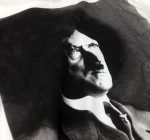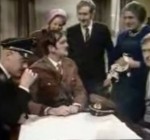
The internet exploded this week with the release of Nicki Minaj’s latest music video for her single “Only.” Employing unmistakably Nazi imagery and aesthetic, and, for whatever reason, released on the 76th anniversary of Kristallnacht, the video struck a bad chord with, well, everyone. The ADL swiftly released a statement criticizing Minaj and her video director Jeffrey Osborne for “trivializing the history of that era,”[1] and Twitter was on fire with fans’ disappointment and critique. On an Entertain This! Poll, 67% of pollers voted that Minaj ought to “apologize for the blatant Nazi imagery.”[2] Within a day, Minaj apologized over Twitter, stating the video wasn’t her idea, and that she would “never condone Nazism in her art.”[3] The director also distanced himself from Nazism, claiming neither he, nor the video, are anti-Semitic. Apologies accepted. Yet, in a response equivalent of “sorry not sorry,”[4] Osborne has stated his concept was deliberate. He explained his video aimed to conflate Nazi totalitarian imagery with American symbols in order to “remind younger generations of atrocities that occurred in the past” to prevent their repetition in the future. This political statement was set rather awkwardly over Minaj’s graphic lyrics about personal empowerment and success.
https://www.youtube.com/watch?v=3rnRdlkuX0I
Canada had a Hitler moment not too long ago. In mid-October, the CBC reported that a shopper took offense to a shirt she saw in a shop on the Plateau Mont-Royal. The shirt, featuring Hitler with an Afro hairstyle, was probably not  a statement of Nazism, either. It was just a ridiculous shirt that either no one thought twice about while blindly hanging it from a rack, or one that for some reason the shop owner found funny, and thought might sell to someone with a similarly poor sense of humour. Yet within a day, that too was “over.” It was, after all, a story labeled as one of a consumer’s personal rage rather than a story about the insensitivity or ignorance of the vendor, or the real phenomenon of novelty Hitler t-shirts.
a statement of Nazism, either. It was just a ridiculous shirt that either no one thought twice about while blindly hanging it from a rack, or one that for some reason the shop owner found funny, and thought might sell to someone with a similarly poor sense of humour. Yet within a day, that too was “over.” It was, after all, a story labeled as one of a consumer’s personal rage rather than a story about the insensitivity or ignorance of the vendor, or the real phenomenon of novelty Hitler t-shirts.

T-Shirt in Thailand. Photo courtesy Vice.com
While neither of these recent examples scream Nazism’s resurgence, they are still unsettling, and force us to ask serious questions about the use of Hitler and Nazi imagery in humour and in popular culture. Can Hitler, or any dictator for that matter, be funny? Many examples of Hitler humour are paired with consumerism. In Thailand, Nazi symbols are often awkwardly blended with anti-capitalist or anti-Western humour on consumer goods, including shirts featuring Hitler as Ronald McDonald, Michael Jackson, or a pink Teletubby. Rather than a conscious critique of consumerism this odd phenomenon seems to be an artifact of absurd and thoughtless capitalism. It embodies its very own critique. Representatives of the Simon Wiesenthal Centre understand the phenomenon as simple ignorance rather than anti-semitism or Nazi-enthusiasm, but Thai shop owners note how popular these items are with young male shoppers.[5] In the same vein, it is understandable that Hitler Nazi imagery may also find its way onto posters, t-shirts, and bumper stickers in places like post-authoritarian Indonesia, a country largely cut off from Western culture and history from the late 1960s until the late 1990s. Many young Indonesians see Hitler as a revolutionary, like Che Guevara.[6] However, the meaning of Nazi symbols and Hitler’s likeness can enjoy no such confusion in the West.
Meanwhile, fascination with and fixation on these symbols takes a very different form in Europe, the cradle of Nazism and the battleground of the Second World War. In a 1969 comedy sketch, the surreal British comedy group Monty  Python had Hitler and his crew “hiding out” in a quiet English bed and breakfast, under very conspicuous names “Mr. Hilter, Mr. McGoering, Mr. Bimmler, Ron Vibbentropp,” and in no disguise at all; the B & B owner and patrons stupidly ignore all of the maps that signal these characters are designing and launching a second offensive. They should know who these people are, but laugh at their eccentricities instead. It is a classic and side-splittingly hilarious skit that pokes fun at Nazis, and British culture and politics. The sketch ends with Mr. Hilter giving an impassioned speech, in German, from a balcony draped with a huge red swastika flag over a tiny English street. A few people watch in confusion, and some complain: “I gave him my baby to kiss, and he bit it!”
Python had Hitler and his crew “hiding out” in a quiet English bed and breakfast, under very conspicuous names “Mr. Hilter, Mr. McGoering, Mr. Bimmler, Ron Vibbentropp,” and in no disguise at all; the B & B owner and patrons stupidly ignore all of the maps that signal these characters are designing and launching a second offensive. They should know who these people are, but laugh at their eccentricities instead. It is a classic and side-splittingly hilarious skit that pokes fun at Nazis, and British culture and politics. The sketch ends with Mr. Hilter giving an impassioned speech, in German, from a balcony draped with a huge red swastika flag over a tiny English street. A few people watch in confusion, and some complain: “I gave him my baby to kiss, and he bit it!”
More recently, German rap group KIZ featured Jewish comic Oliver Polak playing Adolf Hitler in their music video for “Ich bin Adolf Hitler.” The overweight Führer sadly wanders around today’s Berlin completely disconnected from his surroundings, encountering hostility from Arabs and Jews.
Timur Vermes’s 2011 bestselling satirical novel Look who’s back, (2011) takes up this same absurd theme. Adolf Hitler wakes up in a park in modern day Berlin. “Hitler youth Ronaldo!” he calls out to a kid in a football jersey, looking for directions around town. Berliners mistake him for Bruno Ganz, the actor who played Hitler in Downfall, and he gets a job on a program hosted by a Turkish-German comedian. Germans have all but unanimously judged the book a hilarious classic, and it will soon be released as a feature-length film. Daniel Erk’s recent (German) book, translated as “There’s Never Been So Much Hitler – Banalizing Evil or: Why we can’t get rid of the man with the little mustache” looks at this broader phenomenon in German culture, and has commented how this comedy is troubling in that it “stems from the fact that Hitler is someone from a completely different time, which is interesting because there are both perpetrators and victims that are still alive.”[7] While Hitler footage is in black and white, and Hitler himself is dead, his ideology is not.
Thomas Roger’s fascinating piece on Neo Nazi Hipsters, or “Nipsters,” in this summer’s Rolling Stone showed how young ideologues on the extreme Right Wing, the heirs of both Nazism and Neo-Nazism, have used popular “hipster” culture as a vehicle to recast ideas about German national supremacy, immigration, discipline, and national brotherhood as “cool.”[8] Hipster aesthetics, social media, and consumption movements like veganism have been folded into this new/old worldview. This rather troubling phenomenon challenges popular assumptions that Hitler = Nazis.
Furthermore, Erk is disturbed by the idea that this humour is predicated on the idea of Hitler and Nazism are so incompatible with today’s reality. While cultural production employing or commenting on Hitler in Europe has never shied away from comedy, it is never flippant. The images and symbols and characters are employed with engagement and sensitivity to the current local or global context. This cultural production generates thoughtful discussion, serious critique, and interesting (if not disturbing) responses.
The Nicki Minaj video tells us something similar about engagement with the past outside of Europe. Noah Berlatzky’s provocative piece in the Atlantic argued that in fashioning Minaj as a Nazi superpower, “Only” was an unfortunate expression of a power fantasy that employs “a bunch of imagery that seemed like it fit together and would be entertaining/provocative.”[9] Osborne’s cultural critique seems strangely placed in this particular context – a song about Nicki Minaj’s personal successes as an artist. Furthermore, members of Young Money are set up as the “Nazi party” of Minaj’s dictator character, but it is not clear whether or not they are being glorified or vilified. Osborne claims he consciously portrayed Young Money entertainment as a “generic totalitarian regime.” What is the point? Is the video anti-Semitic, anti-establishment, or anti-Lil’ Wayne? Probably none of the above. These images and symbols are totally wasted on this strange video with no apparent connection to the song, to its message, or to the director’s confused goals. Berlatzky is on point when he suggests Osborne used these symbols and images – no Hitler, but still all unmistakably Nazi – to provoke audiences of consumers. This was all just an unfortunate result of a bad video concept.
Yet the real problem with “Only” is the same problem with the t-shirt on St. Lawrence. No one seems to find all this troubling because it isn’t anti-Semitic or overtly Fascist in its message. The shirt was just a joke. The video was a statement on something else. Internet gets angry. Internet moves on. History is in the past. This is the most disturbing trend these examples point to : the absence of a serious engagement with the past. Most people have a vague idea that the Nazis did horrible things, and that Hitler was a madman who was ultimately responsible for all of these bad things. The reality is so much more complicated. While Hitler did play a vital role in the Holocaust, the Nazi genocide of millions of Jews, Roma, and other “undesirables” would have been impossible without the active participation and tacit complicity of ordinary people across Europe and the Americas. The lesson from this past must serve to highlight our present. Genocide and states’ violation of human rights implicates every member of this global community – then, now, and tomorrow.
Historian George Mosse, a German Jew who lived through 1933 and escaped with his family to Britain and then to the US, argued Fascism was a cultural revolution. Yet unlike Soviet Communism, Nazi Fascism was imposed with force from above but simultaneously built on public consensus through popular culture and mass politics. The architects of the Third Reich used media, images, and cultural programs to reach masses of people, and in turn, this captured hearts and imaginations widely. Millions of people bought into this system of ideas and practices. So, while Hitler was a pop culture icon in his time, we must also look to the system and the ordinary people that helped make him into one. And yes, Europe saw WWII in a very different light than did North America. We didn’t “have” Nazis, we didn’t “have” concentration camps (well, we did have internment camps). Yet the Holocaust was a global event, impossible without the tacit and overt complicity and participation of millions of people across Europe and even the Americas. Its aftermath truly was global, too. Thousands of top Nazis were deemed key players in fighting Communists and the US helped give them safe passage across the Atlantic in exchange for their intelligence in the Cold War.

Hitler sells fast food in Thailand.
Humourous depictions of dictators and dictatorships are not all inappropriate, but they are all problematic. We must look at them critically and be prepared to discuss them seriously, rather than take up arms in anger and quickly forget about them when our arms weaken from flailing. Of course I do not want John Cleese’s Mr. Hilter to be retired, and I am very much looking forward to seeing “Look who’s back” when it is released in North America. The right kind of satire, crafted thoughtfully with context, knowledge, and sometimes even irony, should welcome lively debate about the place of the past in people’s everyday lives rather than frivolously offend angry audiences who don’t know how to interpret them.
I do not believe Nicki Minaj’s video is anti-Semitic, neither do I think the Afro-Hitler t-shirt has a racist or Fascist message (although I do think it doesn’t have even a shred of humour in it). However, I am still deeply disturbed by the capitalist commodification of dictators and their dictatorships, especially in locales where significant knowledge of this past exists. I honestly don’t even know what to think about Hipster Hitler, an illustrated web comic “born … in Williamsburg, NY” amidst the “trading of obscure insults over Skype”: a real hipster enterprise. The webcomic portrays Adolf Hitler as an actual hipster, wearing ironic German and Nazi t-shirts – “Skinny Genes,” and “Aryan vs. Predator,” etc. The concept marries the “two most hated memes” in a satire that almost works. My initial thought is that it is somewhat funny, but in an awkward and uncomfortable way. It makes fun of hipster culture from within, and of Nazi culture as a consumer and aesthetic culture from without. But one quick search for “Hipster Hitler” on Amazon yields not only a full-length book of the online webcomics (priced nicely at 14.01 with Prime shipping): you will also find an array of horrible Hipster Hitler-themed paraphernalia. A possible serious engagement with the past has transformed into a capitalist contest for who can possess the most ridiculous iPhone cover: the winner has got to be the Hipster Hitler drinking from a straw remarking “I love Juice.”
These examples offend me not as a Jew, but as a human being. Flippant use of Hitler and Nazi fascist imagery shows us how, in education, popular culture, and politics, history has come to be buried so far in the past that it appears to be “over.” We are history’s most educated generation. We have access to more information, images, and intellectual networks at the touch of a button than could ever have been imagined eighty years ago, when the cultural phenomenon of Nazism was taking root in everyday German life. We may not have been alive in 1933, but people like us were alive.
If we don’t take seriously the fact that ordinary people were implicated in genocidal regimes and elected leaders like Hitler, then how do we make informed ethical decisions about our world today? Joking about crazy madmen and insane historical episodes neatly hides the fact that we too are surrounded by choices- who we vote for, what kinds of things we buy, how we treat the people around us and in places far away.
We can have a laugh, and most of us do, but let’s think about what we’re saying when we characterize Hitler as “hip” or “hilarious”.
[1] http://www.adl.org/press-center/press-releases/holocaust-nazis/adl-deeply-disturbed-by-nazi-imagery-in-nicki-minaj-video.html#.VGK651PF-1M
[2] http://entertainthis.usatoday.com/2014/11/08/nicki-minaj-only-lyric-video-anti-semitic/
[3] http://www.usatoday.com/story/life/music/2014/11/11/nicki-minaj-apologizes-nazi-imagery-in-only-video/18841615/
[4] http://music-mix.ew.com/2014/11/11/only-jeff-osborne-nazi-imagery-nicki-minaj/
[5]http://travel.cnn.com/bangkok/life/hitler-chic-trend-138530
[6] http://www.vice.com/read/hey-indonesia-hitler-was-no-guerrilla-leader-or-grunge-hero
[7] Published in German as So viel Hitler war selten: Die Banalisierung des Bösen oder Warum der Mann mit dem kleinen Bart nicht totzukriegen ist (Heyne Verlag, 2012); http://heebmagazine.com/heeb-interviews-daniel-erk-hitler-expert/44203
[8] http://www.rollingstone.com/culture/news/heil-hipster-the-young-neo-nazis-trying-to-put-a-stylish-face-on-hate-20140623
[9] http://www.theatlantic.com/politics/archive/2014/11/nicki-minajs-nazi-themed-only-video-is-a-potpourri-of-power-fantasies/382588/
__________________________________________________
 Erin Corber is Visiting Assistant Professor of European History at the University of Maine, Orono. A native Montrealer and novice bread baker, she earned a PhD in European history and Jewish Studies at Indiana University, Bloomington in 2013. She is a specialist on modern French Jewish history and teaches courses on the Holocaust, The First World War, and other topics in Modern European history at UMaine.
Erin Corber is Visiting Assistant Professor of European History at the University of Maine, Orono. A native Montrealer and novice bread baker, she earned a PhD in European history and Jewish Studies at Indiana University, Bloomington in 2013. She is a specialist on modern French Jewish history and teaches courses on the Holocaust, The First World War, and other topics in Modern European history at UMaine.





